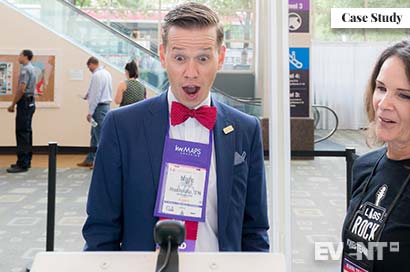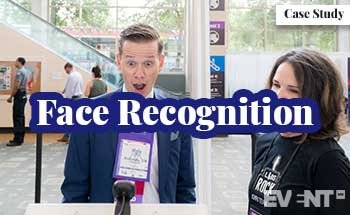

That tremendous growth left Keller Williams organizers looking for a solution that would give them greater insights into crowd flow and easier, more efficient check-in and registration.
The Event
The Family Reunion event brought together thousands of Keller Williams’ top agents, management and executives for four action-packed days of networking and training.
This annual event serves to re-energize attendees with the Vision and State of Your Company presentation and announcements but also assists them in taking their business to the next level by learning from the best real estate entrepreneurs in the business, attending inspiring sessions, and immersing themselves in KW culture.
Quick Facts
- The event lasted four days from February 16-19, 2019
- It was held at the Ernest N. Morial Convention Center in New Orleans
- Over 18,000 agents, managers and KW executives converged on NOLA for this event
The Objective
Keller Williams used the Zenus face recognition service in conjunction with fielddrive’s live badge printing to achieve their main objective: streamlining the registration and check-in process through increased attendee participation in facial recognition.
.
The Challenges
This was the third time KW used facial recognition for easy check-in and registration, so they were able to get ahead of past challenges. To give you an idea of what to look out for in your future events, here are some of the issues KW learned to overcome:
Poor quality images.
Some attendees may upload a blurry image or a group shot, and these pictures are simply not suitable for facial recognition. Implementing an image quality check solves this problem.
A preponderance of noise.
One email call to action won’t result in 100% participation, because of the large amount of ‘noise’ out there vying for attendees’ attention. A campaign involving a few well-timed email reminders improves participation several-fold.
A lack of understanding of the technology.
Getting people to understand the benefits of facial recognition and the security behind it is integral to a pleasant experience. Images are immediately discarded upon enrollment, and biometric data is deleted within one week after the event ends. Zenus never accesses people’s names and email addresses.
Tricky software integration.
The integration process can be a big pain point. However, facial recognition can operate as an add-on, so integration is not always necessary.
Justifying the return on investment.
How does one quantify the return on investment? Facial recognition increases check-in speed by 2-5x, bringing the total transaction time to 9 seconds (including badge printing).
Understanding implementation.
Some event planners who implement facial recognition think they need to spend a lot of time and money integrating it into their registration system. With the help of fielddrive, KW was able to use Zenus’ facial recognition system in conjunction with their online registration software system. Hence, they bypassed what could have been a costly integration without sacrificing any functionality.
How Were the Objectives Achieved?
Partnering with Zenus and fielddrive and using lessons from their earlier events, KW created a quality check and process to optimize results and usage that. Specifically, they implemented the following:
- Using facial recognition software to check people in quickly, no fumbling for tickets or passes
- Ensuring maximal attendee participation with email campaign, directing attendees to a branded microsite and prompting them to take a selfie or upload an image
- Educating attendees on what was in it for them (easier registration and check-in) if they participated
- Prompting registrants for a high-quality headshot if a lesser one was uploaded
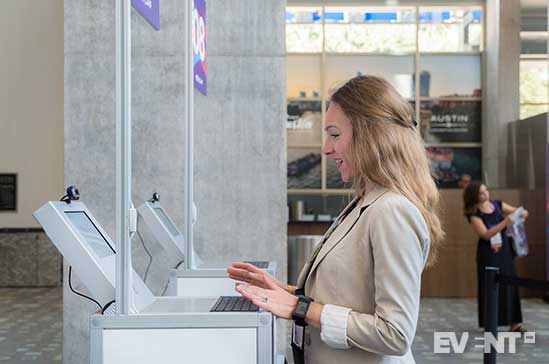

The Road to 68% Attendee Participation
The event was the third use of facial recognition software for Keller Williams, and they wanted to increase adoption and the quality of the images submitted to make the use of the technology much more effective.
Improving the Opt-in for Facial Recognition.
Keller Williams and Zenus personalized the approach they took toward adoption to reduce challenges over the course of three events: Spring Masterminds, Mega Camp, and Family Reunion.


Spring Masterminds (April 2018)
KW asked attendees to upload their photo during the online registration process using the built-in functionality offered by the registration provider.
-
Challenge
Many of the uploaded images weren’t suitable for the facial recognition service.
-
What they learned
A quality check is essential to getting the best images.
Registered attendees: 1,360
Participating attendees: 664
Opt-in rate: 49%
Mega Camp (August 2018)
KW collected pictures online and with a follow-up email campaign. The email campaign included a button prompting registered attendees to submit their headshot. Clicking on the button linked users to a custom-branded microsite developed by Zenus.
This microsite welcomed the attendees by name and offered two options to submit a photo:
- take a selfie
- upload an existing image
Uploaded images underwent a quick quality check to ensure they matched the standards for accurate face recognition.
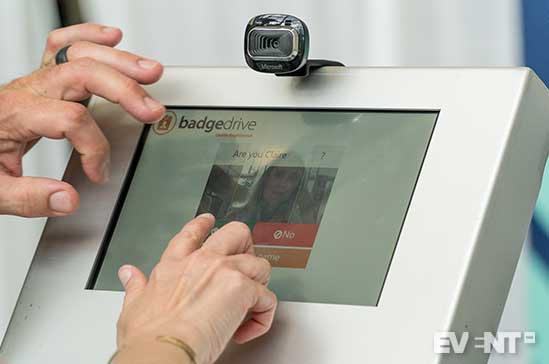

-
Challenge
Pulling images collected through the online registration platform and merging / reconciling them with the images collected through the email campaigns proved difficult.
-
What they learned
Using email campaigns for collecting images would likely have sufficed as thousands of people opted in leading up to the event and a couple thousand on the day of the event itself.
Registered attendees: 8,924
Participating attendees: 5,826
Opt-in rate: 65%
FAMILY REUNION (February 2019)
KW decided to remove the upload step from registration entirely. They used email blasts exclusively. Registrants received a confirmation email, which included a button to submit a headshot. They received follow-up reminders too.
-
Challenge
The confirmation email with the upload button did not produce high participation.
-
What they learned
Personalized emails sent after registration and outside of the confirmation email yielded a higher opt-in rate.
Pre-event Registrations: 17,727
Initial opt-in on the confirmation email: 15%
First email reminder: An additional 28%
Final attendee participation: 12,107
Final total as of the event: 68%
Here is an email example of the scheduled reminders to improve participation:
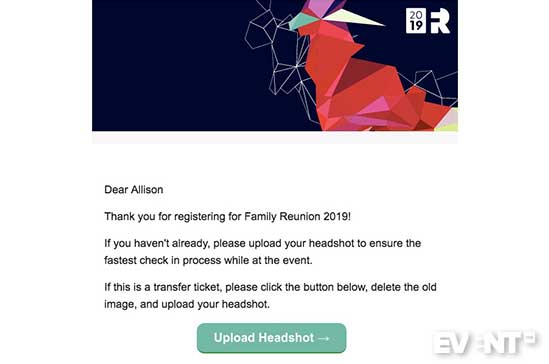

Here are two examples of the image analyzer and quality score using (i) a poor quality image and (ii) a picture suitable for face recognition:
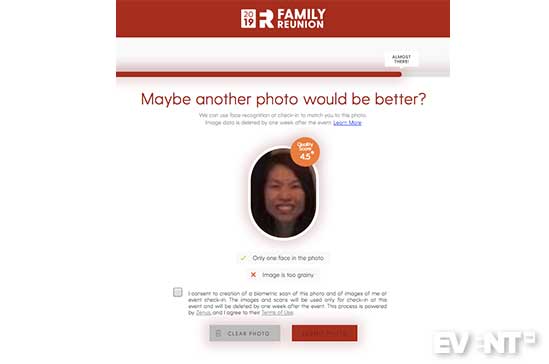

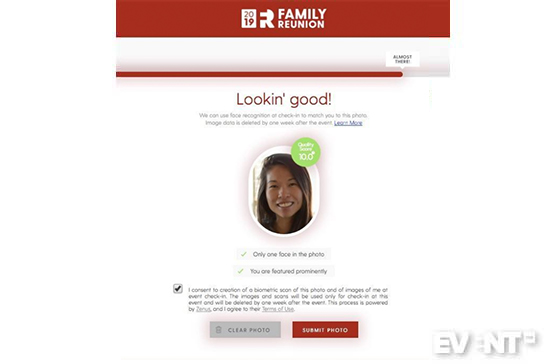

The image collection microsite analyzed the image to check for a number of issues:
- There was no face in the photo
- A group photo with multiple faces was submitted
- The head pose and overall quality was insufficient for facial recognition
Real-time, explicit feedback guided the registrant to ensure proper enrollment.
How Facial Technology Worked At Family Reunion
The day of the event: KW event planners had 15 kiosks fitted with a standard web-camera. As attendees walked toward the kiosks, the camera scanned their face. If a match was found, the system returned a message welcoming them by name. If a match was not found, the attendees were asked to either scan their barcode or enter their name.
The fact that all fielddrive kiosks were equipped with facial recognition made the check-in easy.
Recognition time: under one second
Internet consumption per kiosk: less than 1Mbps.
Attendees did not have to worry about printing out tickets or fumbling for identification.
Data security note: Images were immediately discarded upon enrollment and biometric data was deleted one week after the event ended.
Applied Learning for Your Next Event
Using technology to improve efficiency is a great idea. Here are a few tips for the implementation process:
- Facial recognition greatly reduces check-in time. A smooth check-in experience sets the tone for an enjoyable attendee experience
- Don’t feel the pressure to find facial recognition solutions that have built-in integrations with your existing software. Zenus can be used in conjunction with your other tools, and are available to help you collect the images you need
- Collecting good quality pictures online is essential to success, but don’t leave it up to attendees to judge what’s good quality. Use a system that provides immediate feedback and a quality score
- If directing registrants to a microsite, brand it to the event so they don’t feel like they’re going to an unknown site, and personalize the welcome screen
- Have backup options, like barcode scanning and email lookups on all check-in stations, to keep things moving for attendees who haven’t enrolled for face recognition
- Leave the camera at the check-in kiosk on, and implement face recognition through a video stream (some registration companies use face recognition with still images, and the check-in interface asks the attendees to take a picture and submit it, and then it identifies them, which slows down the process)
- Use face recognition in all check-in kiosks, and not just dedicated lines, because people might not remember if they have uploaded a picture
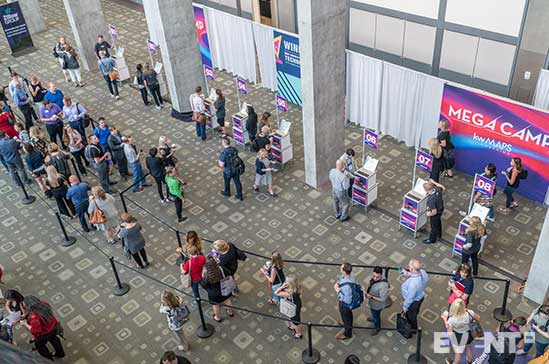

In Conclusion
Facial recognition events are becoming more and more popular due to the increased efficiency in handling large crowds and the qualitative and logistical data planners can derive from traffic analysis.
For planners considering facial recognition, there are some best practices you’ll want to keep in mind, including adding a quality check to ensure a useable image as well as email reminder campaigns and education on the benefits to attendees in order to improve user participation.

